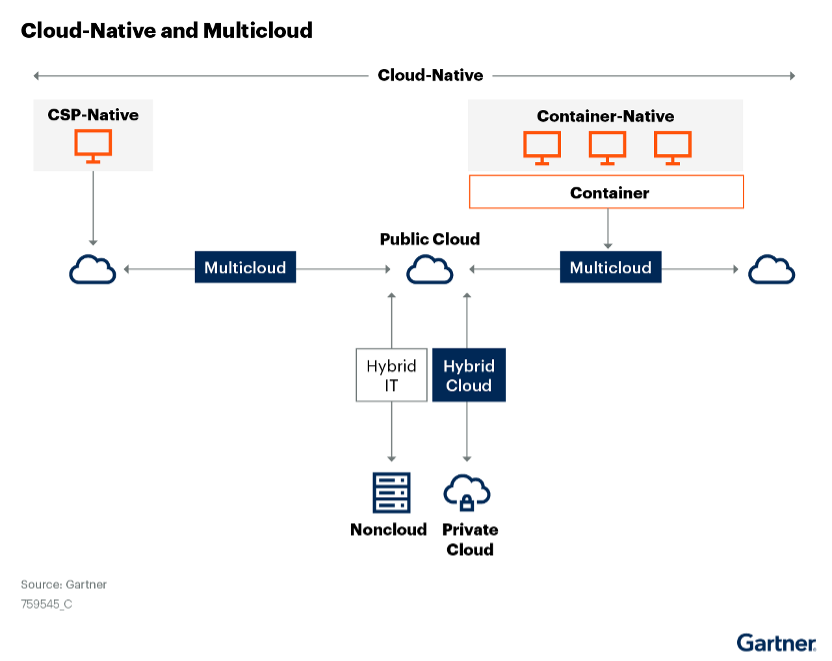
Where are you in your cloud journey? Every company is at a different phase (and every cloud blog is legally required to use the word journey at least once). The public cloud has clearly become a dominant force for newly developed applications and companies due to easy and elastic scalability ‘ whether that means bringing on more resources to meet growing demand or reducing resources (and cost) in times of contraction.
The second choice is private cloud (either on-premises or hosted by a third party), which is generally more flexible and offers improved control and customization to meet your unique business needs. Private cloud may also represent a lower total cost of ownership (TCO). In the last year, we’ve seen more public cloud repatriation into private cloud scenarios to lower costs.
But a third choice has become the dominant pattern for most enterprises: hybrid cloud.
What is a hybrid cloud architecture?
Gartner defines hybrid cloud computing as policy-based and coordinated service provisioning, use, and management across a mixture of internal private cloud services and external public cloud services.[1] In this way, to put it simply, hybrid cloud offers you the best of both cloud computing worlds.
Hybrid cloud architecture combines many of the advantages of both public and private cloud solutions. By incorporating management, orchestration, and automation across multiple environments, a hybrid cloud connects one or more public cloud services as well as on-premises hypervisors and data centers into a single shared control plane.
In modern hybrid clouds, the focus is on the domain of provisioning pipelines and automated processes that can work the same independently of the cloud endpoint. The best hybrid cloud strategy focuses on the business value of a mix of private, public, and hosted clouds while including the right orchestration and automation to bridge the gap.
As for the actual mechanics involved, hybrid clouds work in much the same way as more traditional public and private cloud options. Locations can be connected via dedicated or virtual networking layers or can benefit from distributed worker nodes that create logical connections into a central control plane.
A close cousin of Hybrid Cloud Architecture is the discussion of Cloud-Native Architecture.
Again, Gartner has done quite a bit of work to define this space. The term Cloud-Native is used in many different ways, which adds to confusion but can refer to CSP (or hyperscale) native PaaS services and/or container-native technologies such as Kubernetes.

Is hybrid cloud inevitable?
For most enterprises, a hybrid cloud is an inevitability more than a strategy. That’s because the reality is that over time, multiple business units and teams end up running a heterogeneous mix of private and public clouds. This can be caused by organizational silos, mergers and acquisitions, application demands, and other common factors.
Industry statistics support this conclusion, confirming an accelerating trend. Just three years ago, when a group of nearly 1,000 IT professionals was asked to describe their overall IT approach and strategy, 62% said they were already using a hybrid IT environment with integrated on-premises systems and off-premises cloud/hosted resources.[2] Looking at more recent research, the numbers have approached 80% running a hybrid cloud architecture however over time more and more new applications are being deployed in public cloud endpoints.
Hybrid cloud architecture is also expanding its definition and morphing (pun intended) to ‘distributed cloud,’ which adds edge computing to the mix of public and on-prem endpoints. However, as new applications and use cases continue to push the envelope of what is possible, we are facing more complexity and not less when it comes to orchestrating and managing infrastructure to support those apps.
What are the benefits of hybrid cloud architecture?
The best hybrid cloud architecture offers distinct advantages, but most of these relate back to a single, overarching benefit: the ability for your organization to achieve speed and agility for 100 percent of your workloads no matter where they live.
The hybrid cloud approach expands the available options for aligning specific use cases with your optimal computing environments. Along these same lines, hybrid solutions make it possible to scale computational power to meet business demand on a daily basis. When your resource needs mount ‘ perhaps to match growing demand following a new product launch or to coincide with your company’s peak seasons ‘ the best hybrid cloud architecture can elastically scale or re-platform workloads into the public cloud. In terms of investment, hybrid cloud offers a clear improvement when compared to overpaying for ongoing access to resources in the public cloud ‘ only to have them go unused during times of low need.
Other advantages include improved utilization of on-premises infrastructure, increased agility in responding to change and emergent events, and improved business continuity by enabling failover from private cloud to public cloud options. Hybrid cloud solutions may also offer improved security and risk management by giving your business crucial control over where your data is housed, as well as what technical security measures to include.
What are the challenges and considerations in hybrid cloud architecture?
The analogy of trees and forests comes to mind when looking at hybrid cloud architecture challenges.
Individual application and project teams are going to have an affinity for a specific cloud or set of cloud services based on their needs at any given time (i.e., looking at the trees), but it is the role of the central platform engineering team or cloud operations group to identify leverage points to manage certain elements horizontally across private and public clouds (i.e., looking at the forest).
Forest level considerations transcend specific cloud implementations and include the need for a common security and governance model, consolidated financial controls and reporting, IT service management, and CMDB maintenance.
The need to unify forest management is one reason that Gartner recently identified ‘Management Confluence’ as one of its top 6 trends impacting Infrastructure and Operations leaders over the next 12 to 18 months.
Which hybrid cloud architecture management approach is right for you?
If you’re looking at hybrid cloud architecture options, consider that management approaches can vary depending on the bias and design center of specific tool vendors.
Where do you get started?
Hybrid cloud can definitely bring the best of all worlds, but getting the best experience takes a platform designed from the ground up to bridge the gap being public and private cloud. Morpheus is a 100% unified and agnostic hybrid cloud automation platform designed to bring together hybrid cloud management, container management, and infrastructure automation ‘ all with a common approach to provisioning, governance, provisioning, and cost management.
Built to bring together existing tools and to standardize processes across multiple clouds into a single interface, Morpheus abstracts the underlying cloud accounts, allowing even non-experts to get the most out of a hybrid cloud solution. For complete hybrid cloud lifecycle management, Morpheus is here to help you manage your cloud your way. To see how request a demo today or join our community.
[1] Gartner; Gartner Glossary; Hybrid Cloud Computing; https://www.gartner.com/en/information-technology/glossary/hybrid-cloud-computing
[2] 451 Research; Hybrid Cloud Management & Integration
Essential Technologies for On-Demand IT; 2019